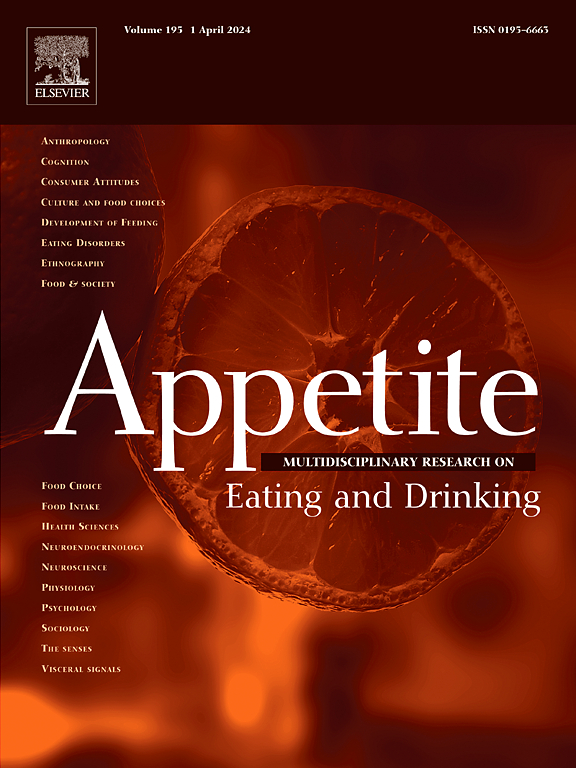四岁西班牙儿童超加工食品消费的预测因素。
IF 3.8
2区 医学
Q1 BEHAVIORAL SCIENCES
引用次数: 0
摘要
近几十年来,超加工食品的消费量有所增加,导致儿童早期饮食质量差,出现某些健康问题。本研究旨在评估4岁儿童的UPF消费,并确定UPF消费的母亲和儿童社会人口学和生活方式预测因素。我们分析了来自INfancia y Medio Ambiente出生队列研究的1736对母子的数据。父母使用经过验证的食物频率问卷报告儿童的饮食,根据NOVA分类计算UPF消费量。我们使用多项逻辑回归来评估社会人口学和生活方式特征与纺织品中儿童UPF消费(低、中、高)之间的关系。平均(SD)每日UPF摄入量为414.6 (240.2)g/d,占每日总摄入量的32.8%。UPF消费的主要来源是超加工乳制品(44.3%)、超加工饮料(17.8%)和甜食(16.5%)。孕妇孕期较高的UPF消费[RRRmedium=1.68 (95%CI 1.23-2.30), RRRhigh=2.86 (95%CI: 2.02-4.04)]和儿童看电视[rrrbb0 1.5小时/天=1.65 (95%CI: 1.21-2.25)]与儿童较高的UPF消费呈正相关,而母亲年龄≥30岁与较低的UPF消费相关[RRR=0.71 (95%CI: 0.54-0.94)]。当按性别分层时,这些关联仍然相似,尽管母亲年龄的影响在性别特异性模型中并不显著。怀孕期间母亲的中等和高UPF消费、怀孕年龄较小以及儿童看电视时间较长与4岁时较高的UPF消费有关。确定与儿童常用药消费有关的因素可支持制定旨在减少儿童常用药消费的健康促进战略。本文章由计算机程序翻译,如有差异,请以英文原文为准。
Predictors of ultra-processed foods consumption in 4-year-old Spanish children
Ultra-processed foods (UPF) consumption has increased in recent decades, contributing to poor diet quality and certain health problems in early childhood. This study aimed to evaluate UPF consumption in 4-year-old children and determine maternal and child sociodemographic and lifestyle predictors of UPF consumption. We analysed data for 1736 mother-child pairs from the INfancia y Medio Ambiente birth cohort study. Children's diets were parent-reported using validated food frequency questionnaires from which UPF consumption was calculated according to the NOVA classification. We used multinomial logistic regression to assess associations between sociodemographic and lifestyle characteristics and child UPF consumption in tertiles (low, intermediate, high). The mean (SD) daily UPF consumption was 414.6 (240.2)g/day, accounting for 32.8 % of the total daily intake. The main sources of UPF consumption were ultra-processed dairy products (44.3 %), ultra-processed beverages (17.8 %) and sweet foods (16.5 %). A higher maternal UPF consumption during pregnancy [RRRmedium = 1.68 (95 %CI 1.23–2.30) and RRRhigh = 2.86 (95 %CI: 2.02–4.04)] and child television viewing [RRR>1.5 h/day = 1.65 (95 %CI: 1.21–2.25)] were positively associated with a higher child UPF consumption, whereas maternal age≥30 years was associated with reduced UPF consumption [RRR = 0.71 (95 %CI: 0.54–0.94)]. These associations remained similar when stratified by sex, although maternal age effect was not significant in sex-specific models. Medium and high UPF consumption of mothers during pregnancy, younger age at pregnancy, and more television viewing in children were associated with higher UPF consumption at age 4. The identification of factors associated with child UPF consumption could support the development of health promotion strategies aimed at reducing UPF consumption in children.
求助全文
通过发布文献求助,成功后即可免费获取论文全文。
去求助
来源期刊

Appetite
医学-行为科学
CiteScore
9.10
自引率
11.10%
发文量
566
审稿时长
13.4 weeks
期刊介绍:
Appetite is an international research journal specializing in cultural, social, psychological, sensory and physiological influences on the selection and intake of foods and drinks. It covers normal and disordered eating and drinking and welcomes studies of both human and non-human animal behaviour toward food. Appetite publishes research reports, reviews and commentaries. Thematic special issues appear regularly. From time to time the journal carries abstracts from professional meetings. Submissions to Appetite are expected to be based primarily on observations directly related to the selection and intake of foods and drinks; papers that are primarily focused on topics such as nutrition or obesity will not be considered unless they specifically make a novel scientific contribution to the understanding of appetite in line with the journal's aims and scope.
 求助内容:
求助内容: 应助结果提醒方式:
应助结果提醒方式:


